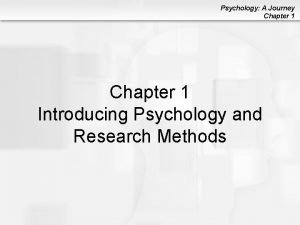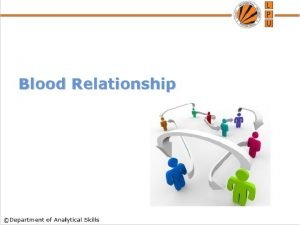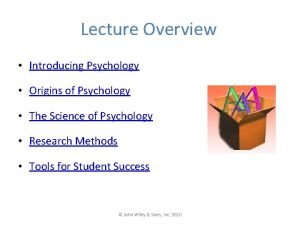Introducing Health Psychology Chapter 1 HEALTH PSYCHOLOGY Richard































- Slides: 31

Introducing Health Psychology Chapter 1 HEALTH PSYCHOLOGY Richard O. Straub | Sixth Edition

Health • State of complete physical, psychological, and social well-being • Health Psychology • Application of psychological principles and research to the enhancement of health and the prevention and treatment of illness

Health Disparities • The United States ranks worst among 11 wealthy nations as measured by life expectancy, efficiency, and accessibility to quality health care by all individuals. • Ethnic majorities in cities have a higher life expectancy; rural, disadvantaged minorities have a lower one • People with European ancestry live longer than African Americans; life expectancy shorter for both these groups than for those in many other countries • Unique health challenges face women, LGBT people, and other marginalized people • Higher disease and disability rates for middle-aged women than for middle-aged men

Preventable Injury and Death Control of underage use and excess use of alcohol could prevent 100, 000 deaths from automobile accidents and other alcohol-related injuries. Elimination of public possession of firearms could prevent 35, 000 deaths. Elimination of all forms of tobacco use could prevent 400, 000 deaths from cancer, stroke, and heart disease. Better nutrition and exercise programs could prevent 300, 000 deaths from heart disease, diabetes, cancer, and stroke. A reduction in risky sexual behaviors could prevent 30, 000 deaths from sexually transmitted diseases. Full access to immunizations for infectious diseases could prevent 100, 000 deaths.

Identification of Actions and Targets for Improving Health Services • U. S. Department of Health and Human Services report Healthy People 2020 identifies specific actions and targets • • • Improving access to health services Eliminating health disparities Reducing chronic diseases such as cancer and diabetes Improving health in people of all ages Preventing injuries and violence Taking steps in 32 other areas

Select Topic Area Goals and Targets of Healthy People 2020 • • • Adolescent Health Physical Activity Nutrition and Weight Status Injury and Violence Prevention Sleep Health

Identification of Actions and Targets for Improving Health Services • Patient Protection and Affordable Care Act (PPACA) • Aims of this federal law • • • Reduce the number of people in the United States who do not have health insurance Lower the costs of health care Improve health care outcomes Streamline the delivery of health care Require insurers to cover certain types of preventive care at no cost to the consumer

Health and Illness: Lessons from the Past (part 1)

Health and Illness: Lessons from the Past (part 2) • Timeline of historical and cultural variations in illness and healing • Prehistoric Period • Good and evil spirits; shaman • Sorcery, exorcism, trephination • Ancient Egypt • Body channels • Ancient Greece • Hippocrates; scientific approach to healing • Humoral theory

Health and Illness: Lessons from the Past (part 3) • Timeline of historical and cultural variations in illness and healing • Ancient China • Traditional Chinese medicine (TCM); internal harmony essential for good health • Qi ˗ vital energy or life force • Acupuncture, herbal therapy, meditation • Ancient India • Ayurveda—oldest known medical system (same time as Buddha) • Body represents entire universe; balance between microcosmic and macrocosmic world; tridosha

Health and Illness: Lessons from the Past (part 4) • Timeline of historical and cultural variations in illness and healing • Post-Renaissance • Biological causes of diseases; Harvey; Fothergill; Hunter • Germ theory of disease • Morton introduced gas anesthetic; Roentgen discovered x-rays • Twenty-First Century • • Biomedical model: Reductionism; disease is result of pathogen Psychosomatic model: Freud Nuclear conflict model: Alexander Multifactorial model: Host, environmental, behavioral, and psychological factors

Health and Illness: Lessons from the Past (part 5) • Timeline of historical and cultural variations in illness and healing • Emergence of Health Psychology • 1978: American Psychological Association (APA) establishes the division of health psychology (Division 38) • Four Goals for the New Field • To study scientifically the causes or origins of specific diseases; that is, their etiology • To promote health • To prevent and treat illness • To promote public health policy and the improvement of the health care system

Twentieth-Century Trends That Shaped Health Psychology Trend Result Increased life expectancy Recognize the need to take better care of ourselves to promote vitality through a longer life Rise of lifestyle disorders (for example, cancer, stroke, and heart disease) Educate people to avoid the behaviors that contribute to these diseases (for example, smoking cigarettes and eating a high-fat diet) Rising health care costs Focus efforts on ways to prevent disease and maintain good health to avoid these costs Rethinking the biomedical model Develop a more comprehensive model of health and disease—the biopsychosocial approach

The Biopsychosocial Model (part 1)

The Biopsychosocial Model (part 2) • Biological Context • Every thought, mood, and urge is a biological event made possible because of the characteristic anatomical structure and biological function of a person’s body • • Genome Genomics • Evolutionary Perspective • Adaptation and reproductive success drive trait and behavior development • Biology and behavior do not occur in a vacuum; they constantly interact • Most important traits are epigenetic • Gene promoters • MAOA gene • DNA methylation • Epigenetic research • Gene–environment effects are always important • Expressed and silenced genes

The Biopsychosocial Model (part 3) • Biological Context • Life-Course Perspective • Focuses on age-related aspects of health and illness • Considers leading causes of death • Overall • By age groups

The Leading Causes of Death in the United States by Age Group

The Biopsychosocial Model (part 4) • Psychological Context • Health and Illness Subject to Psychological Influences • Appraisal and interpretation of stressful experiences • Attitude and treatment effectiveness • Psychological interventions • Positive Psychology • Many studies of the importance of subjective well-being and sense of satisfaction with life

The Biopsychosocial Model (part 5) • Social Context • Ways people think about, influence, and relate to one another and the environment • Birth Cohort • Group of people born at about the same time who experience similar historical and social conditions • Health • Acute disorders • Chronic illnesses

Infant Mortality in the United States

The Biopsychosocial Model (part 6) • Sociocultural Perspective • Focuses on how social and cultural factors contribute to health and disease • Culture • Enduring behaviors, values, and customs that a group of people transmits from one generation to the next • Ethnic Group • Large groups of people who tend to have similar values and experiences because they share certain characteristics • Socioeconomic Status (SES) • Measure of several variables, including income, education, and occupation

The Biopsychosocial Model (part 7) • Discrepancies • Wide discrepancies not only among ethnic groups, but also within these groups • Latinos in the United States: Mexicans, Puerto Ricans, and Cubans (major nationality groups) differ in education, income, overall health, and risk of disease and death • Socioeconomic, religious, and other cultural patterns also contribute to variations • Differences among ethnic groups • Differences across U. S. regions, states, and neighborhoods

The Biopsychosocial Model (part 8) • Gender Perspective • Focuses on gender-specific health problems and barriers to health care • Gender bias in health research and health care • • • Masculinity norms Different treatment of men and women by medical profession Underrepresentation of women as participants in medical research trials

Sociocultural Bias in Diagnosis

The Immigrant Paradox: SES and the Health of Immigrants • Although low socioeconomic status usually predicts poor health, this is not true for Hispanics and other ethnic groups in the United States • What are some possible explanations for this effect?

Applying the Biopsychosocial Model • Emphasizes the mutual influences among the biological, psychological, and social contexts of health • Is based on ecological-systems approach • Well-being is best understood as a hierarchy of systems in which each system is composed of smaller subsystems and at the same time is part of larger, more encompassing systems • Biopsychosocial Model Applied to Health • System at any given level is affected by and affects systems at other levels

Ecological-Systems Approach and Health

A Biopsychosocial Model of Alcohol Abuse

FAQs About a Health Psychology Career (part 1) • What Do Health Psychologists Do? • Teachers, research scientists, clinicians • Positive psychology: New focus on optimal, healthy human functioning • Clinical health psychologists: Licensed practitioners who focus on health-promoting interventions

FAQs About a Health Psychology Career (part 2) • Where Do Health Psychologists Work? • Besides colleges, universities, and hospitals, health psychologists work in a variety of venues, including corporations, HMOs, medical schools, pain and rehabilitation clinics, and independent practices • Source: 2009 Doctoral Psychology Workforce Fast Facts. Washington, DC: American Psychological Association.

FAQs About a Health Psychology Career (part 3) • How Do I Become a Health Psychologist? • General psychology training at the undergraduate level • Special training at the doctoral (Ph. D) level • 4 - to 6 -year program • Curriculum follows the biopsychosocial model • Internship in a hospital, clinic, or other medical setting
 Operational definition of affection
Operational definition of affection Looking for richard
Looking for richard Define politics
Define politics Health psychology definition ap psychology
Health psychology definition ap psychology James lange theory of emotion vs schachter singer
James lange theory of emotion vs schachter singer Social loafing examples
Social loafing examples Signal phrases examples
Signal phrases examples A concise introduction to linguistics
A concise introduction to linguistics 1941-1882
1941-1882 Sentence starters for quotes
Sentence starters for quotes How to introduce a counterclaim in an argumentative essay
How to introduce a counterclaim in an argumentative essay Unit 1 about myself
Unit 1 about myself Talk boost tracker
Talk boost tracker Introducing family members in french
Introducing family members in french Echo verse poem examples
Echo verse poem examples Introduction of digestive system
Introduction of digestive system Kfc founder
Kfc founder Introducing integers
Introducing integers Mpls internet access
Mpls internet access Quotes in mla format
Quotes in mla format Introducing new market offerings ppt
Introducing new market offerings ppt As he himself puts it the art of quoting summary
As he himself puts it the art of quoting summary Introducing windows 7
Introducing windows 7 Khdmdcm calculator
Khdmdcm calculator How to write a biography of yourself
How to write a biography of yourself Contagious diffusion
Contagious diffusion Soni who is dubey's daughter
Soni who is dubey's daughter Introducing the odyssey
Introducing the odyssey Exchange letter format
Exchange letter format Carrying broker
Carrying broker Int family
Int family Relentless improvement safe
Relentless improvement safe






















































